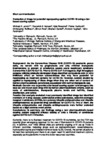Evaluation of drugs for potential repurposing against COVID-19 using a tier-based scoring system
| dc.contributor.author | Jarvis, Michael A | |
| dc.contributor.author | Hansen, FA | |
| dc.contributor.author | Rosenke, K | |
| dc.contributor.author | Haddock, E | |
| dc.contributor.author | Rollinson, C | |
| dc.contributor.author | Rule, Simon | |
| dc.contributor.author | Sewell, G | |
| dc.contributor.author | Hughes, A | |
| dc.contributor.author | Feldmann, H | |
| dc.date.accessioned | 2020-11-17T21:33:30Z | |
| dc.date.issued | 2020-08-03 | |
| dc.identifier.issn | 1359-6535 | |
| dc.identifier.issn | 2040-2058 | |
| dc.identifier.uri | http://hdl.handle.net/10026.1/16659 | |
| dc.description | Embargo removed due to subject matter. | |
| dc.description.abstract |
<jats:sec><jats:title>Background</jats:title><jats:p> As the coronavirus disease 2019 (COVID-19) pandemic grows daily, we remain with no prophylactic and only minimal therapeutic interventions to prevent or ameliorate severe acute respiratory syndrome Corona-virus 2 (SARS-CoV-2). Prior to SARS-CoV-2 emergence, high throughput screens utilizing clinically developed drugs identified compounds with in vitro inhibitory effect on human coronaviruses that may have potential for repurposing as treatment options for COVID-19. However, caution should be applied to repurposing of these drugs when they are taken out of context of human pharmacokinetic parameters associated with normal therapeutic use. </jats:p></jats:sec><jats:sec><jats:title>Methods</jats:title><jats:p> Our aim was to provide a tier-based scoring system to interrogate this data set and match each drug with its human pharmacokinetic criteria, such as route of administration, therapeutic plasma levels and half-life, tissue distribution and safety. </jats:p></jats:sec><jats:sec><jats:title>Results</jats:title><jats:p> Our analysis excluded most previously identified drugs but identified members of four drug classes (anti-malarial amino-quinolones, selective estrogen receptor modulators [SERMs], low potency tricyclic antipsychotics and tricyclic antidepressants) as potential drug candidates for COVID-19. Two of them, the tricyclic antipsychotics and tricyclic antidepressants were further excluded based on a high adverse event profile. </jats:p></jats:sec><jats:sec><jats:title>Conclusions</jats:title><jats:p> In summary, our findings using a new pharmacokinetic-based scoring system supports efficacy testing of only a minority of candidates against SARS-CoV-2 infection. </jats:p></jats:sec> | |
| dc.format.extent | 223-231 | |
| dc.format.medium | ||
| dc.language | en | |
| dc.language.iso | en | |
| dc.publisher | International Medical Press | |
| dc.subject | Antiviral Agents | |
| dc.subject | Drug Repositioning | |
| dc.subject | High-Throughput Screening Assays | |
| dc.subject | Humans | |
| dc.subject | SARS-CoV-2 | |
| dc.subject | COVID-19 Drug Treatment | |
| dc.title | Evaluation of drugs for potential repurposing against COVID-19 using a tier-based scoring system | |
| dc.type | journal-article | |
| dc.type | Evaluation Study | |
| dc.type | Journal Article | |
| dc.type | Research Support, N.I.H., Intramural | |
| plymouth.author-url | https://www.webofscience.com/api/gateway?GWVersion=2&SrcApp=PARTNER_APP&SrcAuth=LinksAMR&KeyUT=WOS:000649396500005&DestLinkType=FullRecord&DestApp=ALL_WOS&UsrCustomerID=11bb513d99f797142bcfeffcc58ea008 | |
| plymouth.issue | 4 | |
| plymouth.volume | 25 | |
| plymouth.publication-status | Published | |
| plymouth.journal | Antiviral Therapy | |
| dc.identifier.doi | 10.3851/imp3368 | |
| plymouth.organisational-group | /Plymouth | |
| plymouth.organisational-group | /Plymouth/Faculty of Health | |
| plymouth.organisational-group | /Plymouth/Faculty of Health/Peninsula Medical School | |
| plymouth.organisational-group | /Plymouth/Faculty of Health/School of Biomedical Sciences | |
| plymouth.organisational-group | /Plymouth/REF 2021 Researchers by UoA | |
| plymouth.organisational-group | /Plymouth/REF 2021 Researchers by UoA/UoA01 Clinical Medicine | |
| plymouth.organisational-group | /Plymouth/REF 2021 Researchers by UoA/UoA01 Clinical Medicine/UoA01 Clinical Medicine | |
| plymouth.organisational-group | /Plymouth/REF 2021 Researchers by UoA/UoA03 Allied Health Professions, Dentistry, Nursing and Pharmacy | |
| plymouth.organisational-group | /Plymouth/REF 2021 Researchers by UoA/UoA03 Allied Health Professions, Dentistry, Nursing and Pharmacy/UoA03 Allied Health Professions, Dentistry, Nursing and Pharmacy MANUAL | |
| plymouth.organisational-group | /Plymouth/Research Groups | |
| plymouth.organisational-group | /Plymouth/Research Groups/Institute of Health and Community | |
| plymouth.organisational-group | /Plymouth/Research Groups/Institute of Translational and Stratified Medicine (ITSMED) | |
| plymouth.organisational-group | /Plymouth/Research Groups/Institute of Translational and Stratified Medicine (ITSMED)/CBR | |
| plymouth.organisational-group | /Plymouth/Research Groups/Institute of Translational and Stratified Medicine (ITSMED)/CCT&PS | |
| plymouth.organisational-group | /Plymouth/Users by role | |
| plymouth.organisational-group | /Plymouth/Users by role/Academics | |
| dc.publisher.place | England | |
| dcterms.dateAccepted | 2020-07-21 | |
| dc.rights.embargodate | 2020-11-19 | |
| dc.identifier.eissn | 2040-2058 | |
| dc.rights.embargoperiod | Not known | |
| rioxxterms.versionofrecord | 10.3851/imp3368 | |
| rioxxterms.licenseref.uri | http://www.rioxx.net/licenses/all-rights-reserved | |
| rioxxterms.licenseref.startdate | 2020-08-03 | |
| rioxxterms.type | Journal Article/Review |


